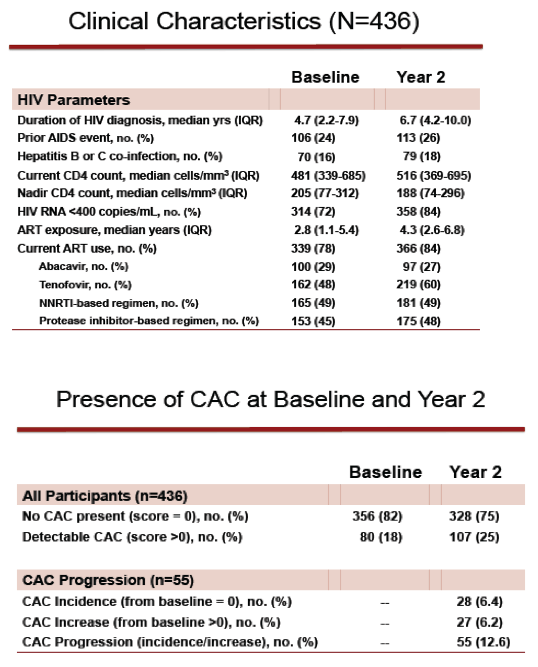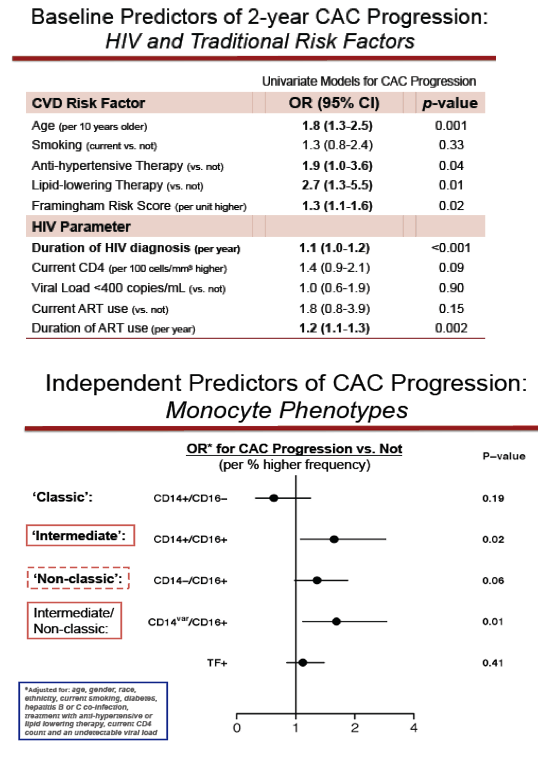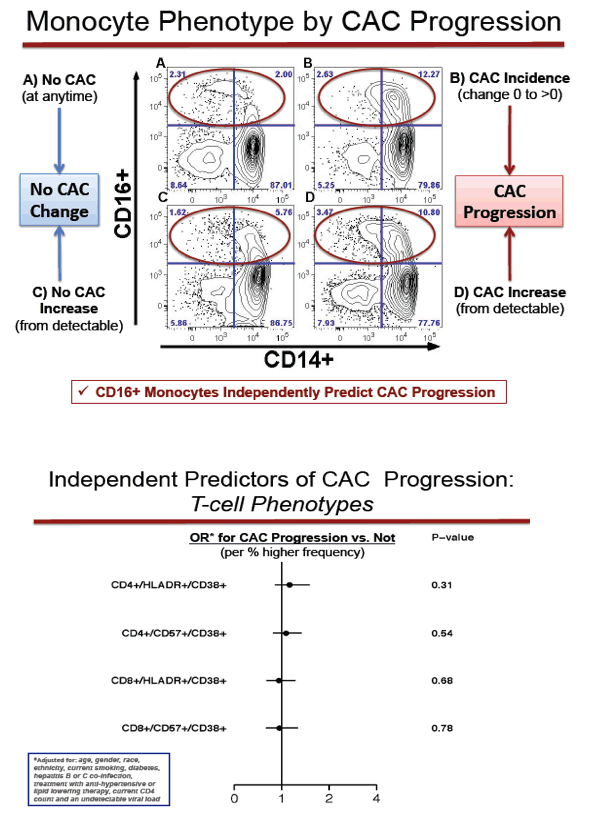 |
 |
 |
| |
Inflammation, Monocyte Activation in CVD & Non-AIDS Events
|
| |
| |
Reported by Jules Levin
CROI 2013
In the oral CVD session where the VA discussed risks for MI, end stage renal disease & cancers, the DAD group discussed CVD, and both discussed associations with age & aging. Age & non-calcified coronary plaque in the MACS were discussed and in some cases an aging affect was found. Then in this session Steve Grinspoon reported from using CT Angiography increased coronary atherosclerotic plaque, subclinical heart disease; see reports from NATAP on all these studies emailed yesterday & in past few days & posted to the NATAP website. So in this session were also presented these 3 following studies which are important because: inflammation markers IL-6 & D-dimer were discussed in the sense of their affect on nonAIDS events & death; (2) 2 studies described below as well as the Grinspoon study find monocyte activation markers may be the key markers identified with driving CVD; (3) the Walker study below finds an intervention that was successful in monkeys.
The objective of this analysis was to estimate the joint associations of IL-6 & D-dimer with the risk of the composite outcome of serious non-AIDS events (SNA)/death in treated, virally suppressed patients. And for a candidate intervention that reduces IL-6 and/or D-dimer, predict the reduction in risk of SNA/death.
In the SMART/INSIGHT Cohort 262 patients experienced a serious non-AIDS event (SNA) or died: cancer 36%, CVD 26%, renal 3%, hepatic 8%, death, other non-AIDS 27%. Using Kaplan-Meier estimates of the cumulative % of patients who experience SNA/death wad overall 7% after 5 years followup. However, patients with the highest level of inflammation marker IL-6 experienced 12% SNA/deaths, and for inflammation marker D-dimer 10% with the highest level of this inflammation marker experienced SNA/death. A 2-fold higher IL-6 resulted in a 44% higher risk for SNA/death, and a 2-fold higher D-dimer resulted in a 25% higher SNA/death risk. Both markers together with 2-fold higher levels resulted in increased risk as well. She reports a 2-fold higher IL-6 & D-dimer score results in 60% greater risk for SNA/death, 37% increased risk for CVD, 51% increased risk for cancer, 188% increased risk for renal & liver disease, and a 100% increased risk for death, all-cause. Again this is data from the SMART/INSIGHT analysis. The question she raises but remains unanswered is if we find a therapeutic intervention to decrease the levels of these inflammation markers can you reduce in fact SNAs and deaths. And she provides a model that could be used in trials of therapy interventions to estimate reduced risks based on how much an intervention reduces levels of these markers. She estimates for example that an intervention that reduces levels of L-6 & D-dimer by 25$ each this would predict a 37% reduction in risk of SNA/death (HR=0.63).
link to webcast of session:
http://webcasts.retroconference.org/console/player/19420?mediaType=podiumVideo
Combined Effect of Interleukin-6 and D-dimer on the Risk of Serious Non-AIDS Conditions: Data from 3 Prospective Cohorts
(from Jules: in her presentation Grund talked about finding therapeutic interventions for SNAs and provided a model on figuring reduced risk with a therapy by showing the effect of reducing inflammation)
Birgit Grund*1, J Baker2, S Deeks3, J Wolfson1, D Wentworth1, A Cozzi-Lepri4, C Cohen5, A Phillips4, J Lundgren6, J Neaton1, and INSIGHT SMART/ESPRIT/SILCAAT Study Group
1Univ of Minnesota, Minneapolis, US; 2Hennepin County Med Ctr, Minneapolis, MN, US; 3San Francisco Gen Hosp and Univ of California, San Francisco, US; 4Univ Coll London, UK; 5Univ of California, San Francisco, US; and 6Copenhagen Univ Hosp and Univ of Copenhagen, Denmark
Background: Despite effective ART, HIV+ patients are at an increased risk of serious non-AIDS (SNA) conditions (cardiovascular disease [CVD], liver and renal disease, and cancers), perhaps due in part to ongoing inflammation and/or coagulation. We use the relationship of interleukin-6 (IL-6) and D-dimer levels with a composite endpoint of SNA morbidity or all-cause death (SNA/death) in 3 large cohorts to predict the effect of reducing IL-6 and/or D-dimer.
Methods: Associations of log-transformed IL-6 and D-dimer levels at study entry with SNA/death were studied using Cox regression in 3766 patients on suppressive ART in the control arms of the SMART (n = 1748), ESPRIT (1446), and SILCAAT (572) trials. All models include age and sex; baseline CD4 T cell count was excluded by model selection. To correct for random fluctuations in IL-6 and D-dimer that attenuate associations between usual levels of biomarkers and disease risk (regression dilution), 3-year longitudinal biomarker data for 235 patients on stable ART were used. Hazard ratios (HR) for lower baseline levels of IL-6 and D-dimer are used to predict risk reductions.
Results: Median (interquartile range [IQR]) for IL-6 and D-dimer were 1.7 (1.1-2.7) pg/mL and 0.22 (0.15-0.35) μg/mL, correlation 0.31. Over mean follow-up of 4.9 years, 262 patients developed an event, primarily non-AIDS cancer and CVD.
In models with only one biomarker, IL-6 and D-dimer were each associated with risk of SNA/death (hazard ratio [HR] = 0.86 and 0.91 per 25% lower levels, respectively; p <0.001 for both). In joint models, both biomarkers were independently associated with SNA/death (p <0.001 for IL-6, p = 0.02 for D-dimer, HR = 0.82 per 25% lower in both), with consistent results across the 3 cohorts (HR 0.80-0.84) and across SNA event types (0.64-0.88). The resulting IL-6/D-dimer score (0.77*log2 IL-6 + 0.33*log2 D-dimer, after adjustment for regression dilution; reliability coefficient = 0.43) was used to predict HR of SNA/death for any combination of 0%-40% reductions in IL-6 and/or D-dimer (Figure).

Conclusions: An IL-6/D-dimer score estimates effects of inflammation and coagulation on SNA/death among treated patients. Findings are consistent across the 3 cohorts. Use of both markers improves precision, suggesting that both pathways contribute. The IL-6/D-dimer score can be used as an outcome for early phase trials aimed at evaluating and comparing treatments with different mechanisms of action for their potential to reduce SNA/death.
----------------------------------------
Therapy for Immune Activation & Heart Disease in Monkeys
Reported by Jules Levin
CROI 2013
Increased monocyyte turnover from bone marrow correlates with severity of SIV encephilitis and CD163 levels in plasma
Plos Pathogens 2011
Soluble CD163 made by monocyte/macrophages is a novel marker of HIV activity in early & chronic infection prior to & after antiretroviral therapy
JID 2011
Soluble CD163, a novel marker of activated macrophages, is elevated & associated with noncalcified coronary plaue in HIV-infected patients
JID 2011
Increased coronary atherosclerosis & immune activation in HIV-1 elite controllers (these elite controllers also have significant increased levels of CD163
AIDS 2012
Arterial inflammation in patients with HIV (inflammation in aorta is de to macrophage accumulation and this inflammation correlates with sCD163)
JAMA 2012 with Editorial AIDS 2013 Perera et al
Hypothesis
- Monocyte/macrophage accumulation in the heart with HIV & SIV infection results in damage indicated by increased levels of fibrosis
- Selectively targeting macrophages with an oral form of MGBG, termed PA300, will decrease marcrophage accumulation & damage in the heart
Summary & Conclusion
- numbers of CD163+ macrophages are significantly increased in the heart during HIV & SIV infection
-Strong correlation between number of macrophages & amount of damage seen in the heart during SIV infection
- BrdU shows increased traffic to the heart during late SIV infection
- PA300, targeting monocyte/macrophage activation decreases numbers of CD163+ macrophages in the heart
- Data suggest that therapies targeting macrophages along with cART may reduce inflammation and damage to the hear during HIV infection
Elevated Numbers of CD163+ Macrophages in Hearts of SIV+ Rhesus Macaques with Cardiac Disease Are Decreased Using PA300
Joshua Walker*1, T Burdo1, A Miller2, K Misgin1, M Sulciner1, M McGrath3, and K Williams1
1Boston Coll, Chestnut Hill, MA, US; 2New England Primate Res Ctr, Southborough, MA, US; and 3Univ of California, San Francisco, US
Background: Increased incidence of cardiovascular abnormalities in HIV+ individuals have been observed with symptoms ranging from myocarditis to atherosclerosis. Pathogenesis of cardiac disease in SIV+ rhesus macaques resembles that observed in humans with activated monocytes/macrophages implicated as playing a role in the development of pathology. We have shown that soluble CD163 (sCD163), in plasma, is a monocyte/macrophage specific activation marker increased in association with non-calcified (vulnerable) coronary plaque in chronic HIV infection. While underlying mechanisms of cardiovascular abnormalities are likely due to a number of factors, we propose that immune dysregulation plays a role in pathogenesis.
Methods: Using an SIV+ CD8 lymphocyte-depleted rhesus macaque model, we examined the role of macrophage activation in the development of cardiac inflammation during infection. We used 12 SIV+ rhesus macaques, and 2 uninfected controls to determine the role of monocyte/macrophage and virus in lesion formation. 8 SIV+ rhesus macaques were treated with PA300, a new oral form of methylglyoxal bis(guanylhydrazone) (MGBG), to examine the effects of inhibiting macrophage activation and traffic on cardiac pathology.
Results: In 12 SIV+ animals, we find 58% have pathological abnormalities in the ventricle tissue including macrophage infiltration, myocardial degeneration and fibrosis. We found a 4-fold increase of CD163+ macrophages in SIV+ monkeys compared to age-matched SIVÐ controls without pathology (p = 0.005, t-test). In SIV+ monkeys with cardiac pathology, we observed a 6-fold increase in the number of CD163+ macrophages compared to age- matched non-infected control animals (p = 0.005, analysis of variance [ANOVA]). Animals with cardiac damage, shown by accumulation of collagen by MassonÕs trichome stain, had the highest number of CD163+ macrophages.
Following a daily oral dose of PA300 beginning at 28 days post-injection for 30 days, the number of CD163+ macrophages decreased as did damage to cardiac tissue when compared to controls. We found a dose-dependent decrease in the percentage of CD163+ macrophages, 10.6%, 54.6%, and 71.8%, compared to controls, in animals treated with 3, 10, and 30 mg/kg/day PA300, respectively.
Conclusions: These data implicate the role of monocyte/macrophage activation in cardiac pathology with SIV infection and point to the potential role of therapies targeting macrophages to inhibit disease.
-----------------------------------------
Monocyte Activation, but Not T Cell Activation, Predicts Progression of Coronary Artery Calcium in a Contemporary HIV Cohort
Jason Baker*1,2, K Huppler Hullsiek2, A Singh3, E Wilson3, K Henry1,2, P Patel4, J Brooks4, H Hodis5, M Budoff6, I Sereti3, for CDC SUN Study Investigators
1Hennepin County Med Ctr, Minneapolis, MN, US; 2Univ of Minnesota, Minneapolis, US; 3NIAID, NIH, Bethesda, MD, US; 4Division of HIV/AIDS Prevention, CDC, Atlanta, GA, US; 5Univ of Southern California Keck Sch of Med, Los Angeles, US; and 6Los Angeles Biomed Res Inst at Harbor-UCLA, CA, US
Background: Chronic inflammation contributes to premature cardiovascular disease (CVD) among HIV+ patients. Identifying immunologic mechanisms that may accelerate HIV-related atherogenesis will help identify new treatment strategies.
Methods: We evaluated coronary artery calcium (CAC) progression in a prospective HIV cohort enrolled from 2004 to 2006 (the SUN Study). We abstracted clinical data and measured CAC by computed tomography scans at enrollment and 2 years later. We defined 2-year progression, using a validated approach, as either: incident (change from undetectable to detectable), or significant increase (difference ≥2.5 on square root scale). We characterized cellular immunophenotypes by multi-color ßow cytometry of baseline cryopreserved peripheral blood mononucular cells (Table) and identified predictors of CAC progression by logistic regression after adjusting for traditional and HIV-related risk factors.
Results: Baseline characteristics for participants with baseline and 2-year CAC assessments (n = 436) were:
median age 42 years, 78% male, 59% non-Hispanic white, 41% smokers, 20% taking antihypertensive therapy, 9% diabetic, median total cholesterol 180 mg/dL, median CD4 count 481cells/mm3, 78% receiving HAART, 72% plasma HIV RNA level <400 copies/mL, and 82% (n = 356) no detectable CAC. At 2 years, 12.6% (n = 55) had CAC progression; 6.4% (n = 28) with incident CAC and 6.2% (n = 27) with significantly increased CAC.
Factors associated with CAC progression included: older age, male gender, antihypertensive therapy, lipid-lowering therapy, and a higher Framingham risk score (p <0.05 for all). The table presents associations between baseline frequencies of immunophenotypes and CAC progression adjusted for traditional and HIV-related risk factors. Higher frequencies of activated monocytes (CD14+/CD16+ or CD14var/CD16+) were independently associated with greater likelihood of CAC progression, but tissue factor expression, and T cell activation and senescence phenotypes were not.

Conclusions: Monocyte activation was independently associated with greater CAC progression in this contemporary HIV cohort. In contrast to T cell activation that has been classically associated with AIDS-related disease progression, these data highlight the consequences of persistent activation of innate immunity for HIV-related CVD risk and emphasize the need for treatments directed at monocyte activation.








|
| |
|
 |
 |
|
|